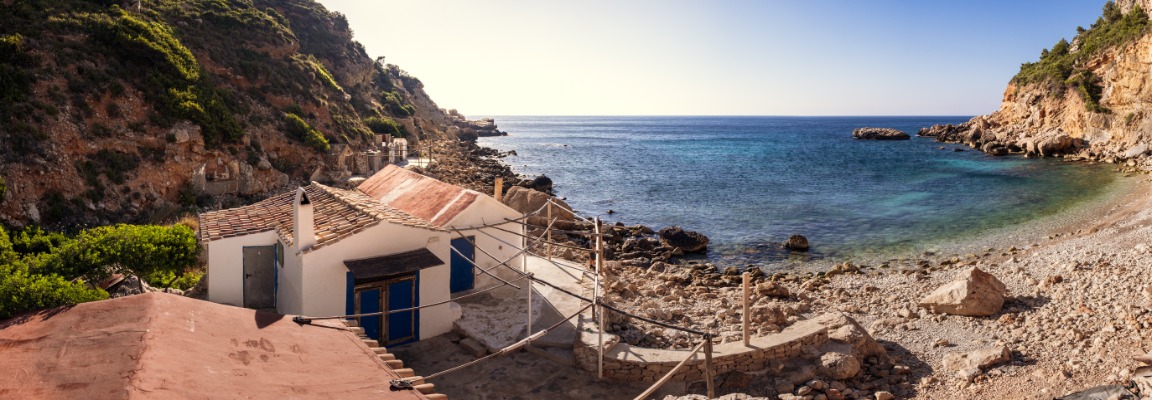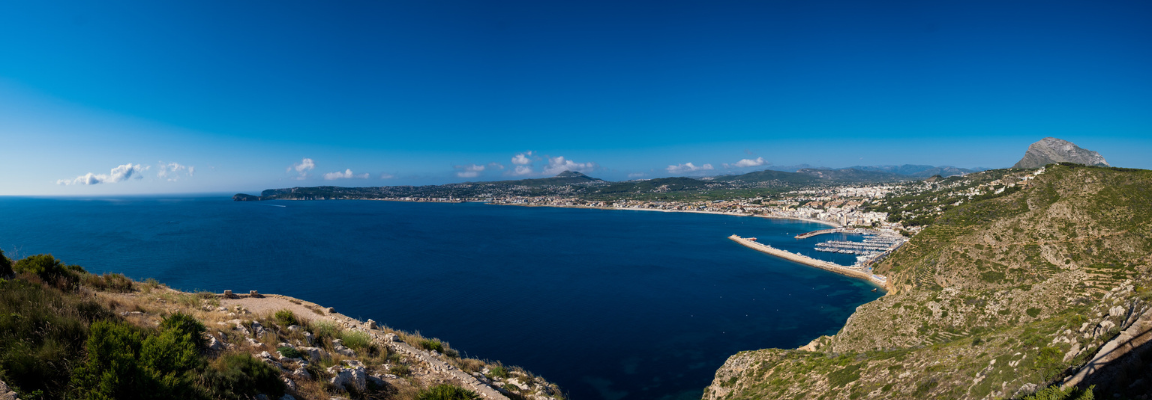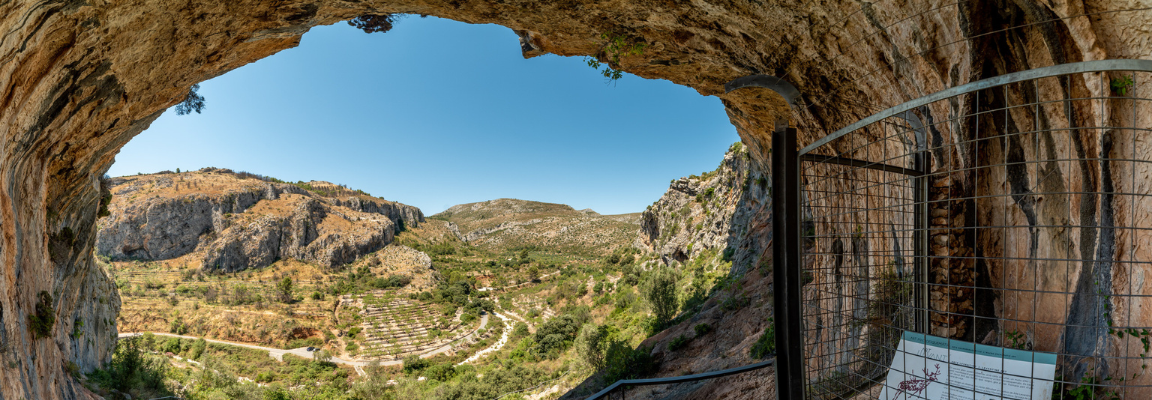This September, the MACMA team put their backpacks on our backs again, but this time to pay tribute to Vicent Andrés Estellés. This year we celebrate the centenary of his birth, when on September 4, 1924, chance and luck wanted one of the most universal and beloved Valencian poets to be born in the bosom of a humble family of bakers from Burjassot. That is why the commemorations and celebrations of this genius of letters cover all the Valencian towns from north to south and from east to west, and the Marina is no exception.
From June 2024 to November 2025 the "Marinant Estellés" exhibition will tour 30 towns in the region, and we came up with the idea... "And if this month's experience allows you to tour the region with the voices what do Estellés' poems recite?". Said and done! We went exploring with our backpack to design a completely different experience in which, over the course of 4 days, we propose that you sit, look around and read or listen to the poems chosen with this motif. Poems that speak and show the Navy in the words of the poet. Discovering and retracing his wake through our towns. Towns that he himself also visited and with which you can fantasize by imagining what Estellés saw and lived.

A BIT OF HISTORY. We know where we come from to decide where we are going.
Estellés' relationship with the Marina Alta region began in 1958, when he visited Dénia in order to write a report commissioned by the newspaper Las Provincias. The author worked as a reporter and he was going to cover the filming of the Hollywood feature film “John Paul Jones”.
That first trip that he would discover for the first time would be followed by others. Sometimes for pleasure, sometimes for commitments to cultural and literary events as a special guest.
Thus, they were able to enjoy the poet in 1973 when he made a tribute to Sanchis Guarner in the IES Historiador Chabàs, in 1975 as a jury of the Dénia Poetry Contest. Also in 1974 when he was the maintainer of the act of presentation of the parties and election of the queen.
In 1978, he took part in the presentation of some “Popular Culture” literary awards and a joint tribute to Joan Fuster, Sanchis Guarner and Estellés himself in Ondara. In 1980 he returned to inaugurate the bookshop Veles e Vents in Dénia and preside over a literary contest in Ondara with Sanchis Guarner.
Also noteworthy are his literary participations in Teulada's Fiestas Programme Book in 1974 or a participation in that publication in the Pedreguer's 1984 Fiestas. There, he dedicated an unpublished poem under the title Estrofes per al meu bon amic Castejón with whom he established a close relationship, following, among other issues, his collaboration with El Llibre de Dénia that was published in 1981.
About the Llibre de Dénia it is worth saying that it frames and exposes all the admiration and love of the poet, not only for Dénia but for the region in general. It is a work divided into 5 parts or books: El tancat, El temps, Record de Ben al-Labbana, Els llocs i Boqueta nit. The book has a spectacular foreword by Isa Tròlec (pseudonym of Joan Baptista Mengual i Llull de Sanet i les Negrals) and which was awarded the Rafael Cornellà Prize for literary portrait in Blanes. In addition, the poems are accompanied by 12 engravings made by the artist Castejón on purpose for this edition. In the words of the philologist Laura Romà Heredia "in Estellés's poetry nothing is accidental and everything is ingeniously linked, he is a master of metaphors through plain language, he is a magician capable of making everyone understand, feel and enjoy his words, and that is why he is the poet of the people. And it is that he manages to describe to us every landscape and every corner of Dénia and the surrounding lands with the hand of memory, longing, experiences, love, “loving” and death”.

PROPOSED DAYS. Step by step we are making our way.
On this occasion the proposed experience is halfway between the literary and the musical. So we will describe points where we recommend listening to the poems recited by the ten voices of La Marina that are part of the “Marinant Estellés” traveling exhibition. At each stop you can read the poems (consult the recommended bibliography) or listen to the poems set to music while observing the details that surround you and that Estellés described so well with words.
Likewise, it is an experience designed to be enjoyed also on the journeys between the different stops. This is why in the purest “Road Trip” style we have prepared a Spotify list with poems set to music, songs, and recitations around the Estellés’ world so that you can travel while feasting your ears:
We could not miss the opportunity to recommend books by Estellés and also readings about the author that can be consulted at the end of this experience so that you can also enjoy reading them while you travel.
The experience is divided into three fundamental parts:
1. Estellés and the Mediterranean: Showing the key landscape points that will make you experience the relationship of deep admiration of the poet and the Mediterranean Sea. In this book, he describes what he sees from the mountains and cliffs of La Marina, and until and everything that does not see what the Balearic Islands are like, imagining legendary pasts and tracing the wake of ancestral times.
2. Estellés, the towns and their people: A part that allows you to discover the towns where Estellés was and fell in love with the people around him and their lives. It is dedicated to love and love, be it more carnal or love for the earth, while masterfully describing the daily life that surrounds each of the streets of our towns.
3. Estellés and the bowels of the mountains: Coming to the end of this literary journey from the coast to the depths of the bowels of the Marina Alta, between ravines, peaks and caves, to show the greatness of the towns humble of our mountainous interior. It is a fundamental part to understand the origin of everything, the essence of our people.
This is where this literary journey begins, following the poems in our exhibition (check the dates and towns to be able to visit it at the end of the news).
First day: Estellés and the Mediterranean I
We start this day early in the morning to visit one of the coves of the Marina Alta, Cala del Llebeig between El Poble Nou de Benitatxell and Teulada. To access it, you will need to lace up your espadrilles and do the Ruta dels Penya-segats that joins Cala del Moraig and Cala del Llebeig. A route of medium difficulty and a total duration of 3 h 40 min (round trip) that allows you to delve into the ancient world of cliff fishing. When you reach the end of the route it is worth stopping to observe the cliffs, the sea fennel that pierces the vertical rocks and the boats on the edge of the sailors' huts. You might finish with a good snack of coques from the village bakery accompanied, if you can, by grapes from La Marina. Traditionally, cocas are held with the left hand and the bunch of grapes is hung on the ring finger of the hand to mix the sweet and the salty at the same time. A delight within reach of those who want to enjoy the local product and quality
After breakfast, it's time to enjoy poem no. 1 of our initiatory journey through the world of Estellés a la Marina with a poem recited by Tomàs Llopis Guardiola, accompanied on guitar by Miquel Pérez Perelló. A poem from the main work of the poet Mural del País Valencià that you can enjoy below:
 Poem: MURAL DEL PAÍS VALENCIÀ DECLARACIÓ DE PRINCIPIS
Poem: MURAL DEL PAÍS VALENCIÀ DECLARACIÓ DE PRINCIPIS

Once we have made this stop, we will redo the path to take our vehicle again and go to Xàbia. Here we will visit one of the two lighthouses that the Marina Alta has, at Cap de la Nau, the easternmost point of the entire Marina Alta and of the Valencian territory. It is surpassed only by the northernmost coast of the coastal strip of Castelló. It also is located just 87 km from Ibiza. A 20-meter tall lighthouse with an octagonal floor plan that dates from 1914, although it was not until 1928 that it was put into operation. The promontory is located above the Cova dels Orgues, described by Cavanilles in the 18th century, and will give you a perfect view of the bays of Valencia and Alicante, as it is at the turning point between these two. If we look to the south we can see the beach and lookout tower of Ambolo and Illa del Descobridor. If we continue our view to the south we will see the sixteenth century Cap d'Or tower of Moraira and in the background, Ifac, impassive and unperturbed, although in the past it wasn't like that. At this precise point listen to the poem interpreted by the sweet voice of Ariadna del Ruste Pérez accompanied by the music composed by the master Enric Murillo Arce.
 Poem: ENYORARÉ DES DE XÀBIA A CALP
Poem: ENYORARÉ DES DE XÀBIA A CALP
It's time to take the vehicle again to head to the other lighthouse in the Marina Alta, that of Cap de Sant Antoni, a lighthouse that lights and marks the way for ships since 1855. It is located in a magical point that allows you to see, if the day is clear, the summit of Penyagolosa in Castelló, the Serra d'Aitana or the island of Ibiza. Here you can listen to the poem recited by Salvador Bolufer Sendra accompanied by Joan Marc Pérez Girau on the piano:
 Poem: COM UN GRAVAT
Poem: COM UN GRAVAT

Follow the road that crosses the entire Montgó natural park while enjoying the panoramic views of the Mediterranean Sea to go to what will be the last point of the day, the Cova de l'Aigua to access it. We will have to take the on the way to Colonia de Dénia, to the point indicated on the map for you to leave your vehicle. You will have to take a section of the path that leads up there, and that is part of the network of paths in the Ruta Groga Natural Park. The section barely takes half a kilometre to reach the cave, although the difference in level you will have to make is 100 meters. Our recommendation is that you go towards the afternoon to be able to enjoy the sunset from the top of the Montgó, on its north face and 350 meters above sea level. The cave has been used since the time of the Iberians and at the entrance you can see some Roman inscriptions from 238 AD, and it has water pipes from the 16th century. Estellés was captivated by its enclave and its history, dedicating the poem that you will hear below with the voice of Núria Gómez Bolufer accompanied on the piano by Joan Marc Pérez Girau:
 Poem: COVA DE L'AIGUA
Poem: COVA DE L'AIGUA
Second day: Estellés and the Mediterranean II
We start this second day in Dénia by visiting its castle. We recommend that you park your car in the Llunàtiks car park and cross the tunnel dug under the Castle used in wartime as an air raid shelter. Then walk through the Plaza del Consell and the Plaza de la Constitucion and go to the entrance of the castle by the stairs to the right of the Consistory building. Continue along Pujada al Castell St. Enjoy the climb to the Palace. Go through the two albacars of the castle until you reach the alcassaba, the last and highest of the enclosures, where you can visit the Archaeological Museum . At the end of your visit, choose a good spot overlooking the harbour to listen to or read the following poem, recited again by Ariadna del Ruste Pérez with music by Enric Murillo:
 Poem: CLARA LA LLUM
Poem: CLARA LA LLUM

When finished, make your way back out of the Castle and walk along Trinquet St, crossing the Roques neighbourhood, one of the oldest and most authentic in all of Dénia. Continue walking and admiring the fishermen's houses in the Baix la Mar neighbourhood, located in the old Muslim quarter, while crossing through Sant Antoni Sq. Then go find Creu Sq, two squares full of life with their berets, where you can stop and have breakfast if you want. La Placeta de la Creu gets its name because in the centre it houses a stone cross. Here, surrounded by the vines that shade the terraces of the houses in the square, listen to the following poem in the voice of Josep Vicent Cabrera:
 Poem: ELS PAREDONS D'ESPESSEÏDA MURTA
Poem: ELS PAREDONS D'ESPESSEÏDA MURTA
Now it's time to go pick up the car to move to another point on our Estellés journey, the Almadrava. It’s a very idiosyncratic stone beach area located between Dénia and els Poblets, where people from the area usually with its table and chairs for dining outdoors in the summer. There you can visit the Almadrava Roman Site, open in summer, an ancient Roman town specialized in the manufacture of amphorae and tegulae. The name Almadrava is due to the fact that it was a place for tuna fishing with this technique. There were galleries of nets that led the tuna to the interior where they were caught with harpoons, one by one, from the boats. Along the entire Mediterranean and up to the tip of Tarifa, the almadraves followed the migratory path that schools of fish used to spawn year after year. On our coasts, tuna fishing has been recorded since Roman times, but it was in the 17th and 18th centuries that it flourished. Francisco Gómez de Sandoval y Rojas, 5th Marquess of Dénia and valid to King Felipe III, was the owner of the tuna factory on this beach in the 17th century. Even King Felipe III visited the factory and caught 19 tuna in a single day (according to his chronicles). Only the remains of the walls, warehouse and chopping room remain of that factory, which you can see at the mouth of the Molinell river, and the Torre de l'Almadrava, a watchtower from the 16th century.
Visit all these points to end up sitting on the pebbles of some of these beaches and listen to the voice of Josep Vicent Cabrera again:
 Poem: ACÍ HI HAGUÉ, FA SEGLES, L'ALMADRAVA
Poem: ACÍ HI HAGUÉ, FA SEGLES, L'ALMADRAVA

You can eat some rice on the side or fresh fish from the market in this area. Take the car to go to Ifac, the last stop of our day and where we will close the Estellés and Mediterranean section.
In Calp, we will be able to follow the Penyal d'Ifac Natural Park Route. You must take into account that every day there is a limitation of 300 visitors to take care of the environment, and you need to book in advance (Book a visit HERE). During the route we can visit the Site of the Medieval Village of Ifac. When you finish your route you can visit the Salines and Banys de la Reina, two emblematic points of the coastal town that will give you two spectacular views of the Rock at nightfall.
You will end the day listening to another delightful poem, recited by Lídia Santacreu Ferrà and music by Eva Ferrer Villena:
 Poem: IFAC LA TEUA ALÇÀRIA
Poem: IFAC LA TEUA ALÇÀRIA
Third day: Estellés, the towns and their people
We change gears and go into the heart of the region to visit the towns that Estellés visited and observed their people. The first stop will be in the town of Benissa, where we will walk through its historic centre early in the morning with its Route through the historic centre where we will be able to enjoy buildings such as: the Sala del Consell, the Batlle houses, the Abargues house, etc. End the walk in the old square, where you will find the Riberers Monument on Puríssima St and sit on the bench that you will find under the shade of the Valencian galley or oak that you will find there. Listen to the poem that Carolina Ferrer Lloret has prepared for you:

 Poem: VIATGE MEMORIAL
Poem: VIATGE MEMORIAL
After this sublime poem we have to make our way to Teulada, one of the towns visited by Estellés in 1974 for the election of the queen of his festivities, where we can have breakfast. In the holiday programme, he also collaborated with a short story that we leave you below:
In Teulada you can walk through the historic centre with its walled Gothic Teulada Route, an area declared BIC (cultural interest asset). Here you can enjoy emblematic buildings such as the Hall of Jury and Justice, the fortress church of Santa Caterina or the chapel of the Divina Pastora. We will stop to listen to the poem dedicated to Estellés' visit to Teulada, with the voice of Lídia Santacreu and the guitar of Eva Ferrer:
 Poem: BURJASSOT, TEULADA
Poem: BURJASSOT, TEULADA
The last stop on the urban route is the Sant Vicent Ferrer cooperative, where you can buy local wine, mistela and vermouth to continue on the road to the next town, Gata de Gorgos.
The road route runs through the Garganta de Gata where if we look up to the left, we will see the iconic Trenet de La Marina that goes from Dénia to Calp and continues to Alacant.
In Gata we recommend walking and shopping in the traditional shops on the road where you can buy objects made of tin, esparto and also wicker furniture, to which there is also a traditional ceramic shop. Head down La Bassa St, where the neighbourhood still maintains traditions such as going out to vigil in the street with bova chairs, or hanging yarn blankets and boixets on the balconies. Highly recommended is the Art al Vent exhibit that has held in August every year, in this street we invite you to enjoy the following poem recited by Joan Femenia Mas and set to music by Enric Casado Navarro:
 Poem: BOQUETA DE NIT
Poem: BOQUETA DE NIT
You can continue in the direction of the town hall where you can visit the Municipal Museum Collection. You can also visit the church of Sant Miquel Arcàngel and have an artisan ice cream at Cal Tramusser, a business with more than 100 years of history (consult all the local artisan businesses in Gata in the following link, you just have to choose the municipality and you will see all the artisan fabric there is to choose from: Gata Artisan Shops).
We say goodbye to the town located in the middle of the middle course of the Gorgos river to enter the slopes of the north face of the Montgó and visit Jesús Pobre, a town surrounded by vineyards and wheat that will delight your visit. While you walk and discover the convent of Jesús Pobre, the farmhouse of Bisserots or the Gran Riurau of Benissadeví (old name of the town). Here we will hear another delight of a short poem, but of great visual impact, with the voice of Salva Bolufer Sendra, accompanied on the piano by Joan Marc Pérez Girau.
 Poem: RIURAUS
Poem: RIURAUS
Before leaving for the next municipality, have lunch in a restaurant in the municipality and try the Coques and some sweets with raisins. From Jesús Pobre we go to Pedreguer, a town also visited by Estellés with whom he had a good relationship through his friend Castejón, with whom he prepared the first edition of the Book of Dénia. Estellés wrote an unpublished poem that was published in the local holydays programme in 1984. It will be the next one you will hear, with the voice of the actress Marina Mulet Gayà from Pedreguer, accompanied on the guitar by the Rosario Caselles Canet. We recommend that you listen while sitting on one of the Pòrxens benches, a 19th-century modernist iron structure in the town square and which is the heart of most of the convoys that take place in Pedreguer.
 Poem: ESTROFES PER AL MEU BON AMIC EL PINTOR CASTEJON
Poem: ESTROFES PER AL MEU BON AMIC EL PINTOR CASTEJON

Next, we recommend that you go and visit the Church of the Santa Creu, where the Baroque frescoes inside, rediscovered in 1974, stand out. Also, the Modernist Route begins here, which allows you to walk the streets of the municipality at the same time visit the main modernist style buildings, with elements such as grilles and balconies, door handles or other unmistakable wall decorations. This 19th century style that highlights a golden age of Pedreguer and all La Marina, where cultivation and Raisin trade made these rich buildings possible.
With another town discovered, we'll hit the road again to finish today and see the sunset from a magical point, Segària - mountain range also known as the stone giant - at its highest point, located in the municipality of Benimeli. We will be able to see on its northern side the entire Marjal de Pego planted with rice and the horseshoe of the Valls mountains, with the neighbouring region of Safor and Mondúver in the background; while on its southern slope the entire Girona basin opens up, with the Rectory at our feet and the Green Horse in the background, the Gran de Pedreguer Mountain in front of us and the Montgó, always undisturbed. In order to reach the viewpoint of the Segària antennas, we will need to go to Beniarbeig to cross the Rectoria on the CV-729 and reach Benimeli. After the village, we will see the roundabout with a detour that indicates the Segària path that we will take until we reach the top, where we can finally hear the poem recited by Júlia Vela Giner:
 Poem: ACÍ HI HAGUÉ, LA CORONADA PÚRPURA
Poem: ACÍ HI HAGUÉ, LA CORONADA PÚRPURA
Once you've seen the sunset and heard the poem, you can have dinner and spend the night at the Rectory to rest and face the last day of our experience. Consult the places to sleep in our special section Where to sleep – By clicking here, you only need to enter the name of the municipalities where you want to sleep and choose the place you like best in the Rectoria.
Fourth day: Estellés and the ins and outs of the mountains
It is a day with a lot of secondary roads, suitable only for those people who like to drive on them, enjoying the mountain landscapes and the views of heights and cliffs. That will pay off for those of you who like to drive on roads. We will get up in the morning to make our way to Pego from where we will go up to the last town of la Vall de Gallinera, Benissili. There, we will walk through the small town where we can visit the church of Sant Pasqual Bailon and its historical laundry venue, and the fountain monumental dating from 1906 with a custodian carved on the stone. We may do a small section of the route of the 8 towns to discover the threshing floor above. Here we will have a beautiful panorama of the town and the castle of Benissili anchored on the cliff of the Serra Foradà. For the reading of the following poem, with the voice of Carolina Ferrer Lloret that will transport us to other times. Where the songs sung while threshing the cereals resounded in this era and the rooms smelled of melons, straws, old oil and carobs:
 Poem: ENLLÀ ON VAJA US HE DE DUR
Poem: ENLLÀ ON VAJA US HE DE DUR
We will leave the Vall de Gallinera along the CV-700 in the direction of Margarida, already the neighbouring region of Comtat. We will reach the detour to the CV-712 to go towards Beniaia, one of the two centers of la Vall d'Alcalà. There we will discover a section that a group of volunteers from the town are recovering, the old road from Beniaia to Alcalà, a beautiful cobbled road that runs between hundred-year-old oak trees. According to the oldest people in the town, other times he walked every day to get to the school, located in the neighbouring town, even when it was all snow. Other times when carts and mules travelled work paths every day. Have breakfast in the shade of one of these trees (the access point to the trail can be found on the attached map) and listen to the next poem, recited by teacher Tomàs Llopis Guardiola and set to music by another teacher Miquel Pérez Perelló:
 Poem: ROMANÍ, FARIGOLA, PEDRES
Poem: ROMANÍ, FARIGOLA, PEDRES
With this beautiful stop behind us, we will continue our journey by car in the direction of Alcalà de la Jovada, where the Moorish depopulated Atzuvieta and the Nevera de Baix are on the roadside. We will pass by Cova del Rull and the neighboring town of Vall d'Ebo. Following the upper course of the Girona river, we will pass by the viewpoint of Barranc de l'Infern. When we arrive at Pla take the CV-715 to Sagra, popularly known as the carretera de pilarets, because of all the pylons that flank the road. When we arrive in the town we will look for the square of the fountains. We may refresh ourselves in the shade of the centuries-old trees and with the water from its fountain to listen to the next poem, at the gates of the Rectory road, again accompanied in the voice of Júlia Vela Giner:
 Poem: EL SALADAR, ELS ULLALS, LES MARINES
Poem: EL SALADAR, ELS ULLALS, LES MARINES

And from the Rectory, in the Vall de Pop, more specifically in Parcent, where we will look for the viewpoint of the Coll de Rates. From here, there is a route known as the Camí de la Pansa or the Camí de les Voltes. In other times it was the scene of attacks by smugglers and bandits such as the Pinet de Tàrbena gang or Pep de la Tona de Pedreguer, among others (which we already discovered in last month's experience). And there we will hear the powerful voice of Joan Femenia Mas accompanied by Enric Casado Navarro, with the Mediterranean in the background, cut by the mountains that surround us, Cavall verd, Segària, the Montgó, etc.
 Poem: COS ENLLACAT
Poem: COS ENLLACAT
It's time to gather strength in one of the bars in Parcent where we can have a very good mountain’ paella before going to our next stop, La Vall de Laguar. With the pantry full we will take the road that will lead us to Murla on the CV-719. We will turn on Sant Antoni St, then pass right by the emblematic Font del gel of la Vall de Laguar to go to Campell, or lower town. From there we will continue up, passing through Fleix, or middle village, and Benimaurell, or village above. We then continue to the Coll de Garga, the point of our next poetic stop and from where there is a beautiful route if you want to extend your stay, PR CV-181 Coll de Garga i Fonts. It will leave us with views between spectacular mountains to listen to the poem recited by Núria Gómez Bolufer accompanied on the piano by Joan Marc Pérez Girau:
 Poem: DINTRE L'APLEC
Poem: DINTRE L'APLEC

And our experience comes to an end with a stop that we could define as magical. We will continue with the vehicle along the Garga pass road that will lead us to the CV-720 in the direction of Castell de Castells. We will follow the upper course of the Gorgos river, here called the Castells river, until we reach the centenary oaks of Petracos, where we will turn right to go to the Petracos site. It is known as the Sanctuary of the Macroschematic art of the central regions, paintings that represent the germination, the fertility, and the family tribe or clan. In other times, it was a point of communion between tribal clans that met here to perform collective rituals. Visit the paintings and when you finish, enter the cave. You will find at the end of the path of the paintings. Sit on that stone, inside the mountain itself, as one who is inside the mother's womb, where everything begins, where we are formed as individuals, with connections, with roots… Look at what you have outside, breathe, and now, listen to the last of our poems, with the sublime recitation of Marina Mulet Gayà and Rosario Caselles Canet, enjoy them and be moved by them, as we have done:
 Poem: RES NO EM POT COMPLAURE TANT
Poem: RES NO EM POT COMPLAURE TANT
**This experience is designed to be done in four days, whether consecutive or on two different days. The MACMA team suggests routes, spaces and buildings to visit, but each person can adapt the experience to their abilities, physical resistance and interests. If you want more information or things to visit in each town, you can go to the Descobrim la Marina Alta website and adapt the experience to your tastes with the backpack.
Recommended bibliography and work by Estelle to accompany this literary experience:
ALABAJOS, Pau (2024). Vicent Andrés Estellés. Valencia And d. Sow books.
ESTELLÉS, Vicent Andrés (1980). Temporary song, Complete work 5 . Valencia Ed. 3 and 4.
ESTELLÉS, Vicent Andrés (1981). Book of Dénia. swedish Printing house Palacios.
ESTELLÉS, Vicent Andrés (2002). Mural of the Valencian Country (3 vols.). Valencia Ed. 3 and 4.
ESTELLÉS, Vicent Andrés (1980). Sonata d'Isabel, Complete work 10. Valencia. Ed. 3 and 4.
You can follow the September experience using this map:

AND MORE. On the table and in bed at the first cry.
 Where to buy |  where to eat |
 where to sleep |  Activities and others |